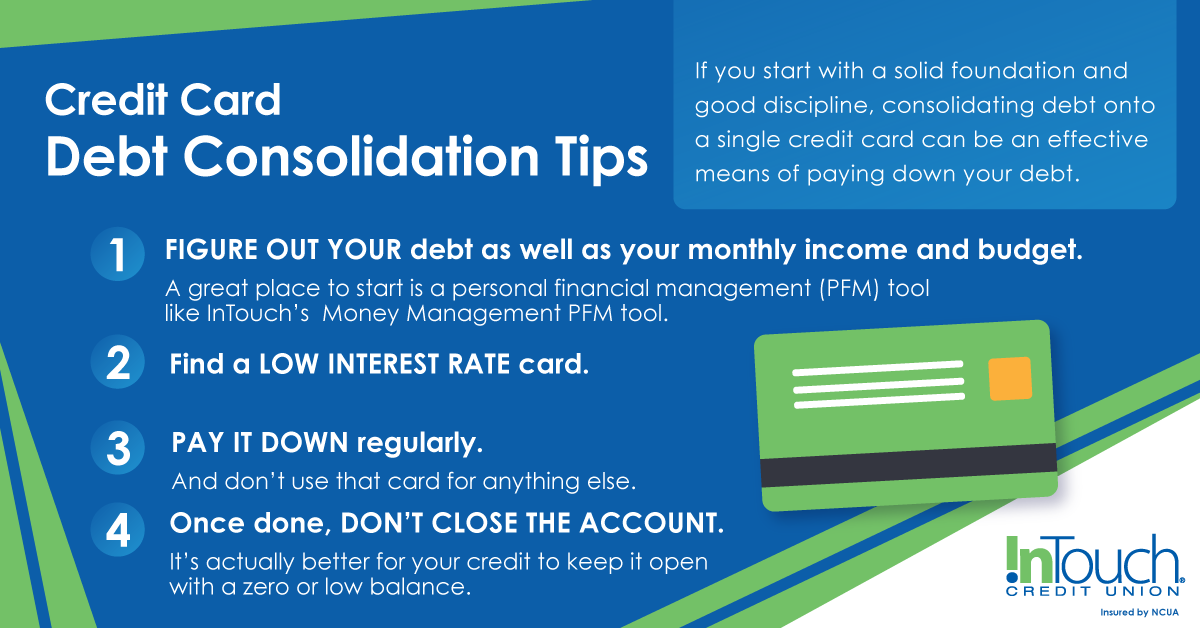Using a Credit Card to Consolidate Debt
Debts, even small ones, tend to accumulate. They collect like leaves until they create a mess that looks difficult to clean up. Furthermore, debts, like leaves, are often easier to remove when you gather them all in one place, which is why debt consolidation is such a hot topic. Debt consolidation combines those little debts so they can be paid off over time with a single, manageable monthly payment. There are a number of popular ways to consolidate debt, and one of them is to combine high-interest debts onto a low-interest credit card. If you have a plan and good discipline, this can be an effective means of paying off your debt.
To Start, Identify All Your Debt
The first step in dealing with debt is always to tabulate the total amount of debt, followed by a clear picture of your monthly income and budget. If you have questions about how to sort out your financial picture, a great place to start is a personal financial management (PFM) tool. InTouch Credit Union offers the Money Management PFM tool as part of your member benefits. You enter your accounts and create a budget using information that you already have.
Being able to see a graphical overview of your budget, your bills, and your income can show you where your money is and where it is going basically in real time. Taking stock in this way makes it possible to see how your finances are stacking up. For a less comprehensive view, InTouch also offers helpful free financial calculators, including a Debt Consolidation Calculator and a Debt Payoff Goal Calculator to help you to work out what your ideal repayment term and monthly payment amount would be.
Try Out Some “What Ifs” With Our Calculators
Pros and Cons of Consolidating with a Low-interest Card
Once you have your own best picture of how you want your repayment to go, you are ready to take the next step. If that is consolidating, and you are looking at putting your debt onto a credit card, then you will want to think about the pros and cons of this approach.
On the positive side, you will be making a single payment, making it easier to track your debt as it is paid down. Paying down your debt on time helps to enhance your credit score, as your debt-to-income ratio improves. Finding a low-interest credit card is the first step, but be careful to understand what kinds of debt you can transfer to the card, and whether there are transfer fees for moving a balance from another credit card. If the credit card you are considering has a transfer fee, go back to the calculator! You may find that the fee is less than the interest savings you would realize by transferring the debt.
More Resources for Choosing & Managing Credit Cards
Credit cards can be a helpful tool in managing your finances, but they need to be chosen and managed wisely. Here are a few more resources to help you step up your credit card knowledge.
Using a Credit Card to Consolidate Debt
Considering consolidating your debt with a credit card? Learn the pros and cons to see if this approach suits your needs.
Buy Now, Pay Later
or Credit Card?
Do Buy Now, Pay Later payment plans provide a good deal for you, or does it make more sense to stick with a credit card?
Like transfer fees, the “cons” of credit card consolidation are really “gotchas” that you need to watch out for as you decide what card to consolidate with. First, some credit cards offer low initial interest rates for balance transfers, but the rate jumps substantially after the first few months. Such a jump can leave you paying more in interest than you would have before consolidating.
You also must watch out for using the card you consolidate with to make additional purchases. Often with balance transfer offers, your monthly payments pay down any purchase balance first, leaving your transferred balances untouched, reducing the impact of the special rate.

Finally, you must be aware of your credit card use while paying down consolidated balances. The most important step in reducing debt is eliminating old debt-producing habits, and not simply spending again because your old credit cards have no balances. You should carefully consider closing your old cards, and the consolidation card should be tucked safely away where you won’t be tempted to use it, since that would add to the debt you are trying to eliminate.
(Special note about closing cards with no balance. Your credit score calculation includes the ratio of unused credit. If you close all unused card accounts, you may actually hurt your score because you have a low ratio of unused credit – a higher ratio of unused credit helps your score.)
Debt consolidation can take some time and effort to do well, but if you take a good, hard look at your financial situation and use the tools that are ready at hand, you should be able to see whether consolidating debt with a credit card is the best route to reduce a pile of debt.
